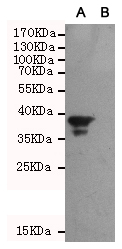- 首页
- 公司介绍
- 热门促销
-
全部产品
-
试剂盒
- |
-
一抗
- |
-
二抗
- |
-
蛋白
- |
-
免疫组化试剂
- |
-
WB 试剂
- PonceauS Staining Solution
- PBST Washing Buffer, 10X
- 1.5M Tris-HCl Buffer, pH8.8
- 1M Tris-HCl Buffer, pH6.8
- 10% SDS Solution
- Prestained Protein Marker
- TBST Washing Buffer, 10X
- SDS PAGE Loading Buffer, 5X
- Stripping Buffered Solution
- Tris Buffer, pH7.4, 10X
- Total Protein Extraction Kit
- Running Buffer, 10X
- Transfer Buffer, 10X
- 30% Acr-Bis(29:1) Solution
- Tris电泳液速溶颗粒
- PBS(1X, premixed powder)
- TBS(1X, premixed powder)
- 快速封闭液
- 转膜液速溶颗粒
- Chemical reagents
- 公司新闻
- 营销网络
- 资源中心
- 联系我们
Bag1 mouse mAb
- 货号:YM1421
- 应用:WB
- 种属:Human;Mouse(predicted:Rat)
- 简介:
- >>Protein processing in endoplasmic reticulum
- 免疫原:
- Purified recombinant human Bag1 protein fragments expressed in E.coli.
- 组成:
- Liquid in PBS containing 50% glycerol, 0.5% BSA and 0.02% sodium azide.
- 纯化工艺:
- The antibody was affinity-purified from mouse ascites by affinity-chromatography using epitope-specific immunogen.
- 储存:
- -15°C to -25°C/1 year(Do not lower than -25°C)
- 其他名称:
- Bag 1;BAG family molecular chaperone regulator 1;BAG-1;BAG1;BAG1_HUMAN;BCL 2 Associated Athanogene 1;BCL 2 associated athanogene;BCL 2 binding athanogene 1;Bcl-2-associated athanogene 1;BCL2 associated athanogene 1;BCL2 associated athanogene;Glucocorticoid receptor-associated protein RAP46;HAP1;Haptoglobin;RAP 46;RAP46.
- 背景:
- The oncogene BCL2 is a membrane protein that blocks a step in a pathway leading to apoptosis or programmed cell death. The protein encoded by this gene binds to BCL2 and is referred to as BCL2-associated athanogene. It enhances the anti-apoptotic effects of BCL2 and represents a link between growth factor receptors and anti-apoptotic mechanisms. Multiple protein isoforms are encoded by this mRNA through the use of a non-AUG (CUG) initiation codon, and three alternative downstream AUG initiation codons. A related pseudogene has been defined on chromosome X. [provided by RefSeq, Feb 2010],
- 功能:
- disease:May be linked to the cryptophthalmos syndrome (Fraser syndrome), an autosomal recessive disorder characterized by the failure of eyes fissures to form during embryogenesis, webbed fingers, and atresia of ear canals, anus, vagina, alimentary tract, or larynx. All these developmental processes require cell death.,function:Inhibits the chaperone activity of HSP70/HSC70 by promoting substrate release. Inhibits the pro-apoptotic function of PPP1R15A, and has anti-apoptotic activity. Markedly increases the anti-cell death function of BCL2 induced by various stimuli.,PTM:Ubiquitinated; mediated by SIAH1 or SIAH2 and leading to its subsequent proteasomal degradation.,similarity:Contains 1 BAG domain.,similarity:Contains 1 ubiquitin-like domain.,subcellular location:Isoform2 localizes to the cytoplasm and shuttles into the nucleus in response to heat shock.,subunit:Binds to the ATPase dom
- 细胞定位:
- [Isoform 1]: Nucleus. Cytoplasm. Isoform 1 localizes predominantly to the nucleus.; [Isoform 2]: Cytoplasm. Nucleus. Isoform 2 localizes to the cytoplasm and shuttles into the nucleus in response to heat shock.; [Isoform 4]: Cytoplasm. Nucleus. Isoform 4 localizes predominantly to the cytoplasm. The cellular background in which it is expressed can influence whether it resides primarily in the cytoplasm or is also found in the nucleus. In the presence of BCL2, localizes to intracellular membranes (what appears to be the nuclear envelope and perinuclear membranes) as well as punctate cytosolic structures suggestive of mitochondria.
- 组织表达:
- Isoform 4 is the most abundantly expressed isoform. It is ubiquitously expressed throughout most tissues, except the liver, colon, breast and uterine myometrium. Isoform 1 is expressed in the ovary and testis. Isoform 4 is expressed in several types of tumor cell lines, and at consistently high levels in leukemia and lymphoma cell lines. Isoform 1 is expressed in the prostate, breast and leukemia cell lines. Isoform 3 is the least abundant isoform in tumor cell lines (at protein level).

- Western blot analysis of extracts from CHO-K1 cells, transfected with a human pEGFP-C1-BAG1 construct (A) or transfected with a human pEGFP-C1 construct (B), using Bag1 mouse mAb (1:1000 diluted).




